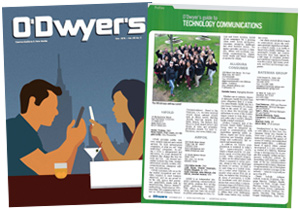|
|
To paraphrase the poet Robert Burns: Oftentimes even the best laid plans need course correction. Maybe, while working through a plan, you see results coming that aren’t what you intended. But often it’s because you’ve determined you hit the right chord while in the midst of your plans, and something is working well and you need more of it. It’s positively impacting the business goals you’ve set in advance of the campaign. And you’ve been able to demonstrate its effectiveness through the use of proper goals and measurement methodologies that key stakeholders agreed to from the start.
|
|
Here’s a quick anecdote. A startup company in the application development space had high aspirations for its product. The company’s executives were convinced that once developers had a chance to use their platform, they would love it. The executives set a goal to increase the number of downloads of its product 3X over the previous quarter. They hoped to do this with a marketing campaign driven by PR and targeted to a specific “app dev” audience. The whole campaign focused on the 3X metric to determine impact and effectiveness.
The company’s PR team was armed with the usual arsenal of news releases, pitch ideas and assorted tactics, and things looked like they were going swimmingly. The downloads were increasing, and the company was well on its way to achieving the 3X metric.
But then a funny thing happened. The PR team discovered halfway through the effort that a growing number of traffic referrals to the download page were being driven by the company’s own employees posting on their LinkedIn profile pages and through Twitter.
Utilizing data that was gleaned simply through Google Analytics, the PR team quickly pivoted to creating more social content in the form of memes and visual elements that could then be shared through these channels. The team kept it light and fun, letting the personality of the company shine through while taking into account the geeky side of the personas they were attempting to engage.
The PR team asked: What would this audience of app developers like even more than visiting the product landing page and sharing with their followers or contacts? A deep dive on the business use of social media. (LinkedIn and Twitter, specifically, were offered for all employees, particularly those in sales and marketing, to add exponentially more shares.) And PR did its part by making sure that when new elements were developed, there was minimal work needed by employees to post and share. (People are busy, so make it easy for them to participate).
The point of this story is that, had the PR team stuck to its original approach, it would have never achieved the 3X objective. The team was willing to recognize a trend and change its approach to promoting the app development accordingly. Realizing there are many different paths to achieve an objective is the lesson learned.
Social media’s impact on buying patterns is forcing companies to be more nimble in their campaign execution. IT buyers aren’t relying just on tried-and-true tactics, but also on research, testing, and friends’ recommendations. Research shows that 97% of IT buyers are influenced by feedback from peer networks like Twitter and LinkedIn, so companies should prepare to course-correct if the data steers them in a new direction.
Setting measurement objectives should come in the beginning of a campaign, not as an afterthought. And the trick is to determine which results will truly define the success of a communications campaign. I am a strong advocate for using the Barcelona Principles, a methodology that encourages companies to quantitatively and qualitatively measure the impact of communications, not the number of “hits,” which is essentially recognized now by savvy communications practitioners as a useless metric.
It’s disappointing to see companies continuing to rely on a quantitative measure of hits to gauge the success of their programs. How many times have you been told, “We received 25 placements for this effort last year, so this year we set 30 as the goal”? Even better, reading an RFP from a tech company that has an aim of X (pick a number) placements during the course of the year. But aside from the obvious desire to count clips, the traditional media side of the communications activity is only half — sometimes not even — of what should be measured.
The social and traditional program elements can be measured in a variety of ways that will demonstrate organizational impact and alleviate you from having to count clips. Message pull through, spokesperson inclusion, standalone appearances, traffic activity and tone weighing are some most commonly used, but this will change based on the objectives and desired outcomes.
To summarize, use the Barcelona Principles methodology as the standard way to measure your program. If you are unfamiliar with it, PRSA has some great resources and conferences available that spell out how it works. In short, it requires that you periodically measure progress throughout the course of a communications program to glean what’s working and what’s not; don’t wait until the end to measure effectiveness or impact. Use the many tools available, such as Google Analytics, Trendkite, Netbase, and others to pull the data.
Be sure to include both the social and traditional components as part of the measurement objectives. One cannot exist without the other. And be creative! Make sure it reflects the company image and is welcomed by the audience. Enlist the help of employees to aid in the communications effort when possible, particularly with social efforts. It’s been said that we all work for sales, but remember that we’re also all brand ambassadors for the company.
Use a balance of quantifiable data — here’s the change in activity — and quantifiable insight — what caused the numbers to change? — to measure effectively. And lastly, build a dashboard that can be used and shared at the board level to report your findings.
Keep it simple and understandable: assume that your work will be passed along without you there to explain all the details on the page.
* * *
Gene Carozza is Vice President at PAN Communications.




 Laura Anderson, who rose to VP/GM of global communications and events in a nearly 20 year stint at Intel, will take on the Americas technology chair at Burson following the completion of the BCW and H+K merger on July 1.
Laura Anderson, who rose to VP/GM of global communications and events in a nearly 20 year stint at Intel, will take on the Americas technology chair at Burson following the completion of the BCW and H+K merger on July 1. WE Communications has partnered with ROKK Solutions to form the WE ROKK AI service.
WE Communications has partnered with ROKK Solutions to form the WE ROKK AI service. In the dynamic world of modern business, effective communication is a pivotal tool for success across various industries. At Communications Strategy Group (CSG®), our expertise in embracing innovation in communication extends beyond traditional marketing strategies, paving the way for transformative industry-specific solutions.
In the dynamic world of modern business, effective communication is a pivotal tool for success across various industries. At Communications Strategy Group (CSG®), our expertise in embracing innovation in communication extends beyond traditional marketing strategies, paving the way for transformative industry-specific solutions. There are two types of tech PR professionals. Which one are you? And are C-suite executives making that decision for you?
There are two types of tech PR professionals. Which one are you? And are C-suite executives making that decision for you? While there’s an impulse to grab reporters’ attention with the newest industry-transforming tech product or service, a back-to-basics approach focused on telling the right stories to the right people is a far more successful way to ensure your technology campaign breaks through the clutter of today’s crowded tech landscape.
While there’s an impulse to grab reporters’ attention with the newest industry-transforming tech product or service, a back-to-basics approach focused on telling the right stories to the right people is a far more successful way to ensure your technology campaign breaks through the clutter of today’s crowded tech landscape.


 Have a comment? Send it to
Have a comment? Send it to 
No comments have been submitted for this story yet.